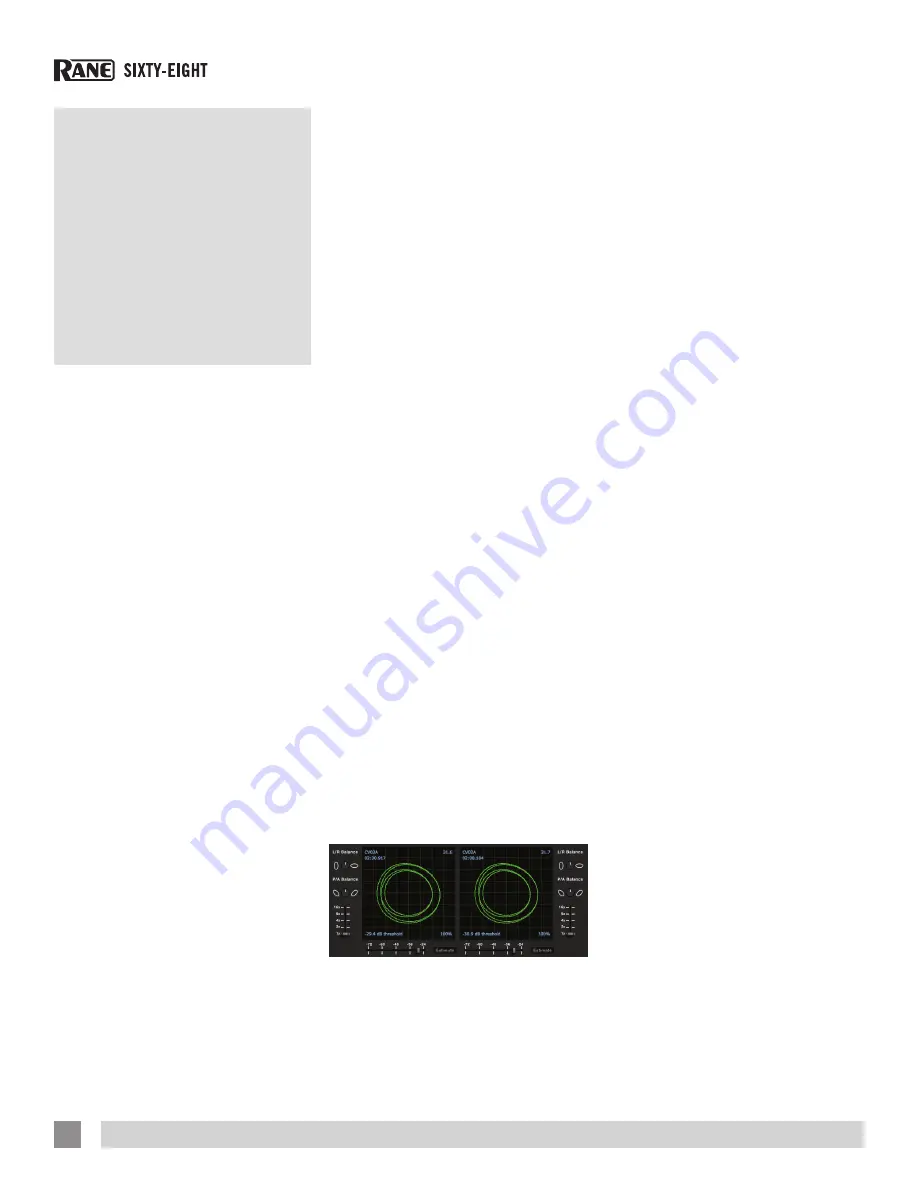
How to Calibrate Scratch Live
With music playing in the background
(from any source), put your needle on
the record with the turntable
stopped
.
If you are using CD players, the same
rules apply. Have the CD deck paused
or stopped while calibrating. Ensure the
input level in Scratch Live is set correctly
to accept a LINE level signal.
See “Input
Select Status” on page 44.
Click and hold the estimate button
until the slider stops moving. Moving
the threshold slider to the left will make
Scratch Live more sensitive to slow record
movement, but also more sensitive to
background noise.
Repeat the process for each deck.
Things to remember:
• Your needle must be on the record.
• Your turntable (or CD player) must be
stationary.
• The background music playing must be
at a similar level to which you will play
your set at.
• Calibrate Scratch Live every time you
play.
TIP: If the slider jumps to the far right,
then you have a problem with noise
in your turntables/CD players/mixer.
Check all your connections and make
sure your equipment is well earthed.
In some situations you will not be able
to improve the signal quality, and you
will have to play on regardless. In this
situation, stick to REL mode.
The Scopes
The scopes on the Setup screen in
Scratch Live display the input signal as a
phase diagram. The key factors to look at
on the scope display are crisp clean lines,
round shape, and the tracking percentage
in the lower right corner.
Calibrating
Scratch Live
Since Scratch Live is controlled by an
analog signal, there is no guarantee of
what state that signal will be in by the time
the software gets to interpret it. Therefore,
Scratch Live needs to be able to handle a
wide range of signals, and be configurable
to use them optimally. Calibrating is just
configuring the software to your situation.
Calibration is equally important for both
vinyl and CD users of Scratch Live.
There are two parts to the Scratch Live
control signal: The directional tone, and
the noise map. Listening to the control
vinyl, the directional tone is the 1 kHz
tone. The noise map sounds like random
noise over the top of the tone.
The directional tone provides the
current speed and direction of the record,
while the noise map tells the software
precisely where on the record the needle
is currently.
The Noise Threshold
A threshold is a lower limit, below which
a process will not occur. In the case of
Scratch Live, the noise threshold is the
limit below which the input signal will not
be interpreted as control signal; in other
words if it’s below the threshold, it is
considered noise and ignored.
This setting is necessary because a
stylus is very sensitive, and will inevitably
pick up noise from the environment as
well as the signal on the record, especially
in the noisy environment of a live show.
Start both turntables or CD players. You
will see green rings appear in the scope
view
as shown.
For optimal performance the inner ring
should be as close to circular as possible.
Use the scope zoom slider (
1x to 16x
)
to zoom in or out as necessary. Use the
scope
L/R Balance
and
P/A Balance
controls to adjust the shape of the inner
ring.
The number in the top left corner of the
scope view gives the current absolute
position within the control record or CD.
The number in the top right corner is
the current speed in RPM. In the bottom
left is the current threshold setting, and
the number in the bottom right shows
the percentage of readable signal – this
number should be close to 85% when
your system is calibrated properly.
Calibration Troubleshooting
After calibration, the number in the upper
right corner of the scope view should say
0.0 while the needle is on the record and
the turntable is stopped.
If that number is fluctuating then
manually move the Estimate slider to the
right until that number is stable at 0.0.
If you’ve moved the slider all the way
to -24 and its still fluctuating then you
have a grounding or interference problem
somewhere in the chain.
If so, the first thing to check is that
the grounding wire coming from your
turntable is connected to a Sixty-Eight
grounding post.
Next, make sure that the Sixty-Eight
isn’t sitting next to a power source
such as a power strip and that the RCA
cables aren’t laying across other power
conducting cables.
If you are still experiencing issues, you
might have to adjust the placement of
your setup. For example, make sure bass
bins aren’t directly under the turntables.
If you have trouble getting the rings
circular, you probably need to clean or
change your needles.
If the image appears as a line, then
you have a missing channel. Check your
wiring and n
eedles. For more calibration
troubleshooting help
see “Scope
Reading and Fixes” on page 50.
RANE SIXTY-EIGHT MIXER FOR SERATO SCRATCH LIVE • OPERATOR’S MANUAL 2.4.4
20






























